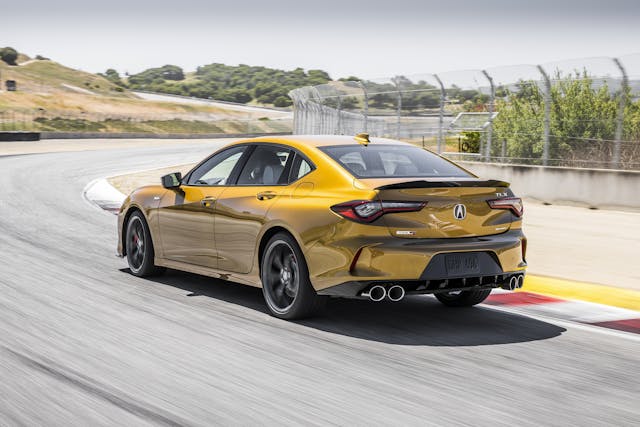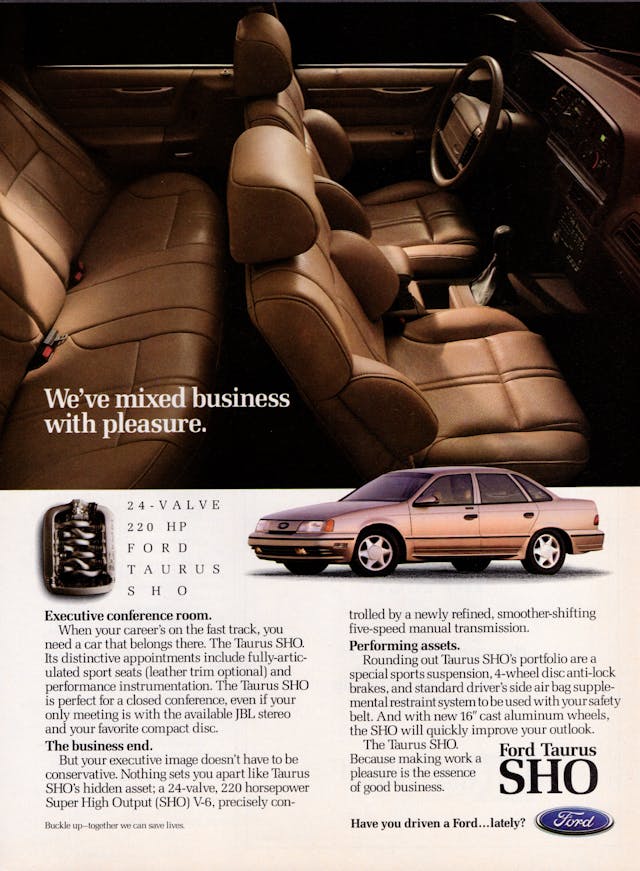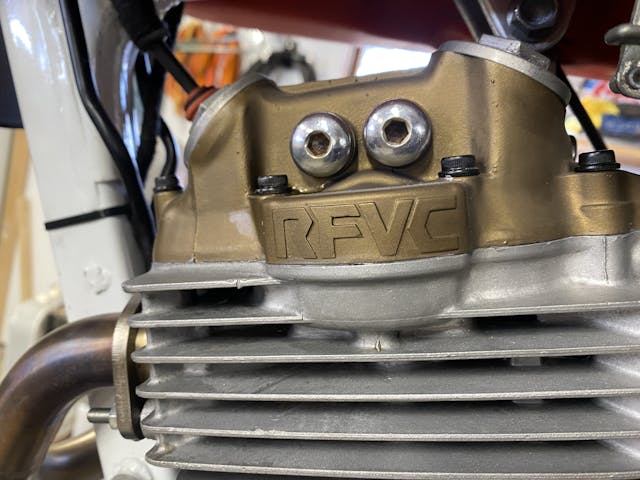Can you decode these 6 badges?
A few weeks ago, we published an article that placed you, the reader, in a hypothetical traffic jam. All around you were cars from various eras and manufacturers, sporting badges with confusing or unknown meanings.
The mix of letters and numbers clinging to trunk lids and fenders with double-sided tape are a kind of a secret language that’s always satisfying to decode. More often than not, once we’re out of the car, or the mystifying acronym is out of site, we forget to search online for the solutions to these little puzzles.
So we decided to save you the time and give you the rundown on six more badges you might encounter in the wild.
Check them out!
COPO

If you know, you know that Chevrolet’s Central Office Production Order (COPO) system gave dealers the means to get cars from the assembly line that the company didn’t publicize or specify on its order forms. The system was initially meant for ordering fleet vehicles, but of course it was also manipulated to build hot rods.
The ZL1 code, for example, was what an aspiring racer needed on their order form to get the all-aluminum 427 big-block that was originally designed for Corvette race cars … but the engine shortly found a home in Camaros. ZL1, by the way, was never an official Chevrolet designation until 2012, when it became a trim on the baddest track-focused Camaro in the lineup.
VTEC

Engines are tuned for the jobs they need to perform. That could mean low-rpm response for pleasant city driving, high-rev shove for a track-slaying sports car, or stump-pulling torque for a work truck. But what if you need an engine to respond to a variety of situations?
Honda’s solution: VTEC.
The four letters stand for Variable Valve Timing & Lift Electronic Control System. The tech can be traced to the 1984 New Concept Engine program, and it became a staple of Honda engines in the 1990s.
Utilizing two camshaft profiles and a valve lifter that is only actuated during high-rpm use, VTEC engines functionally have two cam profiles that can be tailored individually for optimal performance across different rev ranges.

These days nearly every manufacturer employs some version of variable valve or lift timing, and even big V-8 engines like Chevy’s small-block can run on four cylinders to save fuel. Some variable setups have better reputations than others, but none has the following or associated lore of Honda’s VTEC, which young tuners to this day respect.
SH-AWD

2005 doesn’t sound like it was so long ago, but check your calendar. It’s been eighteen years!
The automotive landscape in the mid-aughts was radically different than today’s. All-wheel drive was just starting to become common in mainstream cars, and Acura was on the forefront of developing new technology to compete with that of longtime experts Subaru and Audi.
Short for Super Handling All Wheel Drive, SH-AWD doesn’t earn Acura any points for naming creativity. But the Japanese brand should be credited for designing one of the first all-wheel-drive systems with true torque-vectoring capability.

Technically an evolution of the VTM-4 (Variable Torque Management four-wheel drive) system that debuted in 2001, Acura’s SH-AWD can send up to 70 percent of engine torque to the rear wheels and actively distribute up to 100 percent of that torque to a single left or right wheel to aid handling and traction.
SH-AWD is still in use today, in everything from the MDX family hauler to the show-stopping NSX supercar.
SHO

Ford gave birth to a beast when it shortened Super High Output to SHO and stuck the badge on the back of the Taurus for 1989. Luckily, the Yamaha-built, 220-horsepower V-6 backed up the bold name, along with a sport suspension, upgraded brakes, and cast-aluminum wheels.
The SHO was supposed to only last a few years, but after selling 15,519 Taurus SHOs in the very first year—at a hefty price of $19,739 (equal to about $45,840 today)—it proved a special model worth keeping around.
The first-generation cars (1989–91) have already achieved collector-vehicle status. Ford even brought the moniker back for the 2010 model year until it died with the Taurus in 2019. With Ford now using its Focus-famous ST badge on sportier SUVs these days, could SHO be gone forever?
STI

Short for Subaru Tecnica International, this group was created in 1988 to develop a worldwide image of competitive motorsports associated with the Subaru brand. (No, we didn’t leave out the “h” in Tecnica. That’s how Subaru wants it spelled.) The abbreviation quickly became synonymous with the highest-performance cars Subie sold, and these cars made their mark on rally stages around the world.
Early STi cars were Legacy-based, but the platform swapped to the Impreza’s in 1992 and ultimately took the form of the 1994 Impreza WRX STI, which sadly didn’t make it to U.S. shores for sale until the 2004 model year. If turbocharged boxer engines shoved into rally-infused four-doors are your thing, the STI is your flavor of fun.
Though early examples are now bonafide collector cars, Subaru made the strange choice of discontinuing the STI (all caps, as of 2006) for this latest iteration of the WRX.
RFVC

Back to Honda-land, but this time we are talking two wheels … and a badge that is literally cast into parts rather than stuck on to a body panel.
The Radial Four Valve (combustion) Chamber is a complicated way of saying “hemispherical cylinder head,” but it did keep Chrysler’s patent lawyers off everyone’s back.

In an effort to improve airflow, the four valves that control air and fuel flow through the cylinder were canted outward slightly, making a shallow dome with its apex at the spark plug.
Honda wasn’t the first to develop this design and was arguably late to implement it when the new-for-1984 XR-series bikes hit the market. However, like so many other manufacturers, Honda was keen to highlight the technology as a bragging point in marketing efforts. This design is widespread across a variety of modern engines, but it’s the Hemi crowd that still toots its horn the loudest.
For its part, the RFVC casting can still be found on the Honda XR650L, which has remained virtually unchanged since 1993.
***
Check out the Hagerty Media homepage so you don’t miss a single story, or better yet, bookmark it. To get our best stories delivered right to your inbox, subscribe to our newsletters.


First Honda with RFVC was the 1983 XR350. Which also had a seperate carburetor for each intake valve.
The bike got me…never rode a Honda bike, so today is the first time I’ve seen those letters…
I also forgot the word “lift” in VTEC, but got the rest of them.
We could do 5-6 of these every week for a while…
STI always made me think STD. Substituting infection for disease.
I had many Honda RFVC bikes, and it is a good thing the engines were heavy and overbuilt, because they lasted a long time. However, the top end was very complex, requiring a double rocker arm system to transfer the cam motion to the radial splayed valves. Lots of parts, expensive to overhaul. The Husqvarna/KTM engines went back to parallel valves and simple rocker arms, and the industry had to follow. A good example of “over engineering.”
No WS-6?
Let’s not forget the most common one. CAIT Couldn’t afford it then.
All this Honda love and no mention of CVCC? Although, that was like 40 years ago now….
A Taurus might be a SHO, but it’s still a Ferd Taurus.
What I could use help with is the present day Cadillac model names. STS, DTS, XLR, etc…
I guess you never drove a Ford Taurus SHO. It blows the doors off any chevy monte rusto.
When is that GM versus Ferrari movie coming out?
To be honest, I wasn’t aware that CVCC was an acronym and not just a string of letters until you pointed it out here.
CVCC=Compound Vortex Controlled Combustion
Learn something new every day. Good one to point out!
Chevrolet HHR?? A chev salesman told me it stands for High Heritage Roof. I did not believe him.
Eric- that’s just out of order. It’s Heritage High Roof. True story
Thought the “HHR” was a short version of “Haa Haa ROFL” because that’s what a lot of folks did when they saw one !
And Please don’t forget Honda’s CVCC engine.
Hello.What about the S.V.O.[Special Vehicle Operations ] Mustang. 175-205 hp Depending on the year..A lot of T-bird, Turbo coupes were made.
Only a few thousand, per year, of the Mustangs were made.1984.1985,1986.
England got the Mitsubishi Evo FQ-400 and yes it stands for F-ing Quick.
I so want some of these badges. Badass.
Kyle Smith needs to educate himself on the intricacies of the four stroke cylinder head. A radial pent roof is as far removed from a hemi as you can get, short of a side valve. The Westlake style combustion chamber minimizes area exposed to the flame front which maximizes efficiency and power. The hemi on the other hand is a band aid solution to increase valve area at the expense of sinking a ton of heat into the piston, decreasing efficiency and increasing fuel consumption.
The RFVC head has the valves canted both radially and axially. The combustion chamber is spherical. You can see in the last image of this article: https://www.hagerty.com/media/maintenance-and-tech/can-you-improve-a-factory-cylinder-head-with-20-minutes-of-work/ in case you are not familiar with the XR head specifically.
Maybe I am missing something but it seems like most of the “pent roof vs Hemi” hinges on number of valves? Is there a resource you recommend to research further? Would love to learn more.
Read Kevin Cameron
I regularly read Kevin Cameron’s work. Huge fan of his. Have yet to come across one of his columns that touched on pent roof vs hemi chambers though. Will admit it is only recently that his book “Classic Motorcycle Racing Engines” is next in line on my shelf though. Looking forward to opening the cover on that one.
Bill- No need to attack the author here. This is not an article about “The best combustion chamber available” it is an article about decoding acronyms.
That being said a pentroof combustion chamber is absolutely based on a hemi chamber. With some changes to address the inefficiencies you addressed. The radial pentroof takes it one step farther and angles the valves. Actually making it closer to a conventional “hemi” chamber than a standard pentroof chamber.
The heart shaped “Weslake” is definitely a great chamber design. One that I personally prefer over a hemi, however Kyle Smith spoke truth in what he said about combustion chambers.
Last side note: the fastest accelerating piston engines on earth use a hemi chamber. 0-100mph in 0.8 seconds.
The car we bought our driver’s permit toting son in 2016 is a 2003 Acura tl. I still can’t see VTEC without adding a “-yo” to the end…following his regaling us with modified Honda videos.
Being a (then) hormone addled teenage male he couldn’t help mention to his mom (my wife) that the car is the fastest in our little fleet. The car at least has some safety features and somehow survives to this day. Unlike the 1966 Caddy I had at his age that (hypothetically)got light in the front end at 120 mph, had a single lap belt, and an impale-o-matic steering column if you came to grief!
Seen all these before ho hum🙄
You forgot about the Saab EMS (Eat My Shorts)
Great article, as always!
Thanks
Michael